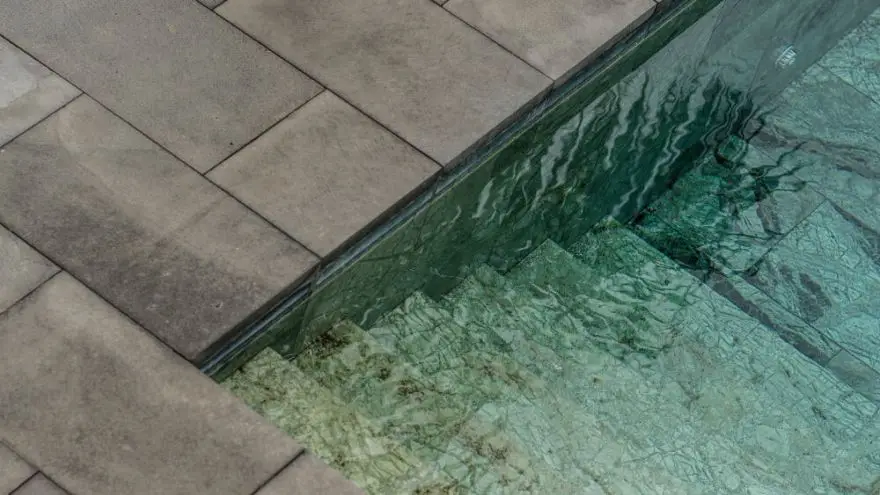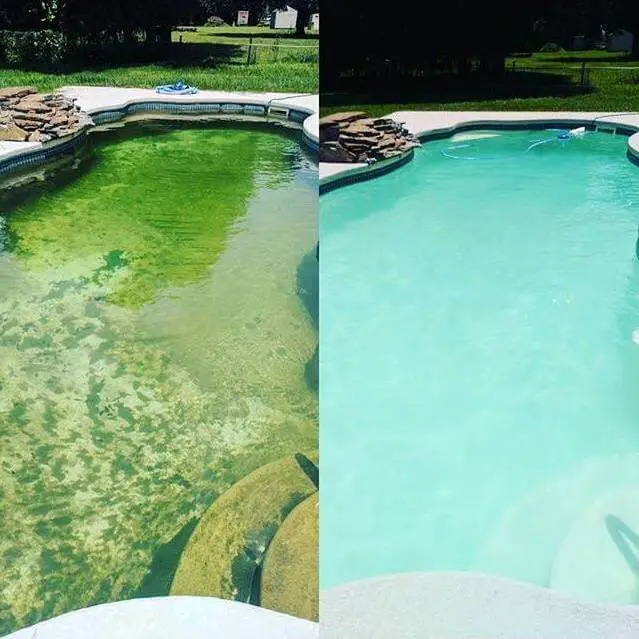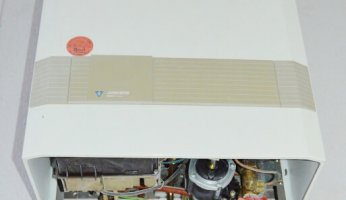Restoring The Crystal Blue Water To Pool Water That’s Turned Green
 Restoring The Crystal Blue Water To Pool Water That’s Turned Green
gearweare.net
Restoring The Crystal Blue Water To Pool Water That’s Turned Green
gearweare.net
When the crystal blue water in your backyard swimming pool turns a muddy shade of green, algae growth has overwhelmed your water. The plant-like organism flourishes in pools that are not properly sanitized and filtered. While the most common algae are green or blue, variations in yellow or black can also pollute the pool.
Table of Contents
Why You Should Not Swim In A Pool with Algae
Swimming in a pool with small algae growth may not be deadly, but it leaves a slimy residue on the skin – a turnoff to most swimmers. It makes the water cloudy enough to block what is below the surface.
As the tiny plant overtakes the area, it can develop bacteria such as e-coli that are dangerous to humans and animals, especially if a swimmer swallows a mouthful of infected water.
Common health risks associated with algae in the pool include:
- Rashes and skin infections, especially if there is already a break in the skin
- Increased risk of falling on slippery surfaces
- Eye infections such as conjunctivitis
- Infections from swallowing infected water
How Does Algae Get Into The Pool?
Algae bloom out as spores or seeds that blow into the pool when windy and rainy. Once the sun hits the spore and photosynthesis occurs, the algae begin to grow.
The pool algae die off if the pool water is properly maintained with a balanced blend of chlorine and other chemicals. Otherwise, it forms layers on the water surface and surfaces such as pool floors, stairs, decks, rails, and even around filters and skimmers.
As layers thicken, the algae become more resistant to chlorine.
4 Common Causes Of Algae Buildup
While a pool owner cannot stop algae from trying to invade a pool, the plant finds a welcome environment when the chemicals used in the water are out of balance.
1. Low chlorine levels
Chlorine is the basis of compounds such as chlorine gas, sodium hypochlorite (liquid bleach), calcium hypochlorite, lithium hypochlorite, and chlorinated isocyanurates that release hypochlorous acid (HOCl), the active pool sanitizing agent. Chlorine kills bacteria that can lead to infections and control algae.

The right level of chlorine needed depends on factors such as how often you use your pool or spa, the number of swimmers who use it, the water temperature, the amount of recent rain, and contaminants in the water (like suntan lotions and oils).
While local safe rules vary, the recommended minimum of “free available chlorine or bromine” is measured in PPM (pounds per million, with 1 pound of chlorine in 1 million pounds of water); 1-3 ppm is the standard for residential pools and 3-5 ppm for residential spas and pools.
Sanitizers become less effective when tree leaves, grass, bugs, and suntan lotion contaminate the water and make a welcome environment for algae growth.
2. High cyanuric acid (CYA) levels
Even after putting chlorine in your pool, UV rays of the sun can destroy it after 17 minutes of exposure, so you still need to stabilize the chemical balance with cyanuric acid.
Adding a CYA stabilizer to outdoor pools and spas extends the life of your chlorine by 3-5 times. However, too much stabilizer can also decrease the effectiveness of chlorine.
There are 3 measures of chlorine in a pool: free chlorine, chlorine combined with water and contaminants, and total chlorine. Only free chlorine can disinfect water and should be at a 2-4 PPM level. When the amount of free chlorine is vastly different from the total chlorine level, chlorine lock occurs, and the chemical is no longer working.
Simply adding more chlorine won’t solve the problem; using a cyanuric acid stabilizer reducer is the easiest way to break a chlorine lock and effectively sanitize the pool.
The proper chlorine balance to CYA is 7.5:1, so in a pool with 3 ppm of chlorine, the CYA is 40 PPM. Keeping the proper ratio of free chlorine and cyanuric acid prevents algae growth and bacteria formation.
3. High pH levels
The water in a pool should have the right balance of acidity and alkalinity to keep the chlorine active, prevent eye and skin irritation, maintain clear water, and avoid damage to vinyl pool liners and corroding surfaces. When pool water chemistry is off, especially if the pH level is too high, algae growth goes wild and leads to green pool water.
Noted on a scale of 0 to 14, pH levels below 7.0 indicate acidity, while 8.0 indicates that the water is acidic or basic. The proper pH level is 7.5 to 7.8. Fortunately, pH increasers (bases) or pH decreasers (acids) can bring the pH to the appropriate level.
4. High phosphate levels
Phosphates develop in your pool from dead leaves, lawn waste, lawn fertilizer, and many other sources and act as a superfood for algae growth. As they use up chlorine quickly, phosphates make the algae hard to kill.
Fortunately, high phosphates are not unhealthy if levels remain below 1,000 PPB. As the water turns green from algae growth from excessive phosphates, it becomes unhealthy, uninviting to swimmers, and more costly to remedy.
A Shocking Cause of Green Water – Metals in the Water
To prevent algae and contaminants from getting out of hand in a pool, you should “shock” it by adding chlorine or non-chlorine pool chemicals to the cloudy water once a week to raise the “free chlorine” level. Events such as a pool party, a big rainstorm, a significant change in water levels, or finding poop in the pool call for more frequent shocking.
When refilling the pool and shocking the pool with chemicals, the pool may turn green if the water has a high level of copper or iron. In this case, the green color results from the water, not algae growth.
The water can return to its desired color by adding a sequestrant to prevent the metals from coming out in the solution or a chelating agent to extract and track metal particles in the pool water.
Keeping Ahead Of Green Water Formation
If the pool water has turned green, changing it back to its desired blue requires an effort that might take up to 2 weeks to undo the damage.
Shocking the pool with chlorines every day for 3 or 4 days may remove the green, but running the filtration system 24 hours a day and backwashing the pool daily for 7-14 days is necessary to remove the green color and cloudiness of the water.
A pool owner who wants to prevent or correct green water in their pool, spa, or hot tub must routinely clean the water, test chemical levels, check pool filters and other components, and add appropriate chemicals to keep the water safe and appealing.
Most people can manage routine pool maintenance on their own, which requires about 1.5 hours per week and an expenditure of up to $100 per month.
Those with more money than time can hire a pool service to maintain the pool and ensure that the water chemistry is right and the water a crystal blue rather than algae-induced green.











